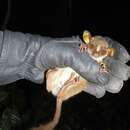Biology
provided by Arkive
The unusually large eyes and ears of Demidoff's dwarf galago are essential adaptations to its nocturnal lifestyle (8). Hunting during the night, it uses its acute senses to follow inconspicuous prey through the dense foliage (2) (8). Small insects, such as beetles and moths, form the bulk of its diet, but it will also forage for fruits and gums (2). The day is spent sleeping in fully enclosed leaf nests or in tangles of vegetation, anywhere from 5 to 40 metres off the ground (2) (9). Usually these nests are occupied by a single galago but occasionally two or three females will share a nest with their young. Males, on the other hand, are extremely aggressive towards one another, and seek to control exclusive home ranges that overlap those of as many females as possible. Generally it is the heavier males that control the largest territories (2).
The female usually has just one pregnancy each year, lasting around 133 days. The tiny infant weighs just 5 to 10 grams at birth, but after a month is normally able to follow its mother on foraging bouts. The young is weaned at around 6 weeks and reaches sexual maturity at around 8 to 11 months (2).
Conservation
provided by Arkive
There are no known conservation measures in place for Demidoff's dwarf galago, but it is present in several protected areas (1). In addition, this species is listed on Appendix II of CITES and consequently can only be traded internationally under a permit (3). In order to inform conservation efforts, further taxonomic research is necessary to assess whether some geographic populations should be regarded as separate subspecies, or even species (7).
Description
provided by Arkive
Demidoff's dwarf galago is not only the smallest species within the bushbaby family, but also one of the world's smallest primates (4) (5). In common with other bushbabies (or galagos), the narrow head of Demidoff's dwarf galago is dominated by large immobile eyes, capable of penetrating the darkest forest nights, and enormous ears that it can turn independently in the direction of predators or prey (2) (4). Long slender digits with opposable thumbs are adaptations to its arboreal lifestyle, and a lengthy tail acts as a balancing aid (6). The woolly fur is grey to reddish-brown overall, but the underparts and flanks of the limbs are considerably paler than the rest of the body (2) (4).
Habitat
provided by Arkive
This strictly arboreal species is only found in primary or secondary forest (2).
Range
provided by Arkive
Demidoff's dwarf galago occurs from Senegal across to western Tanzania, and on Bioko Island in the Gulf of Guinea (1) (2). Insufficient evidence is currently available to assess whether several distinct geographic clusters of Demidoff's dwarf galago actually comprise separate subspecies, or possibly species (7).
Status
provided by Arkive
Classified as Least Concern (LC) on the IUCN Red List (1) and listed on Appendix II of CITES (3).
Threats
provided by Arkive
Demidoff's dwarf galago is threatened in some parts of its range by habitat loss associated with deforestation and conversion of land for agriculture. Nonetheless, these actions are not thought to be having a significant impact on the overall stability of its population. Consequently, this species is classified as Least Concern on the IUCN Red List (1).

